
Pengenalan
Dalam prinsip kejuruteraan perisian, salah satu kaedah menyelesaikan spesifikasi keperluan (keperluan pengguna) adalah berfikir secara objek. Ini bermaksud masalah atau keperluan sesebuah perisian perlu dianggap sebagai sebuah objek yang mempunyai beberapa fungsi tertentu di dalamnya. Dalam dunia sebenar, perisian dan perkakasan (hardware) yang hendak dibangunkan perlu dianalisis secara teliti, difahami secara mendalam dan konsep ‘domain’ masalah tersebut perlu jelas.
Analisis Berorientasikan Objek
Mengenalpasti ciri-ciri dan konsep objek dalam sesebuah masalah. Secara ringkasnya, analisis OO ini memastikan para pembangun atau pengaturcara perisian pada jalan yang betul dalam menyelesaikan masalah tersebut mengikut kepakaran masing-masing. Satu objek boleh dipecahkan kepada beberapa sub-objek dan setiap satunya mempunyai masalah berlainan dan diselesaikan oleh orang yang berlainan.
Sebagai contoh, sebuah kereta mempunyai beberapa bahagian tertentu yang sama-sama menjalankan fungsi sebagai sebuah kereta. Bahagian tersebut adalah enjin (satu objek), stering (satu yang objek yang lain), cermin sisi dan sebagainya. Objek-objek tersebut mempunyai fungsi yang khusus dan berinteraksi antara satu sama lain bagi menggerakkan sebuah objek (kereta).
Begitulah juga dalam membangunkan perisian atau program berskala besar. Contohnya, Sistem Penyuraian dan Pemantauan Trafik Bandaraya Kuala Lumpur terdiri dari beberapa komponen dan dibahagikan tugasnya bagi memudahkan penyelesaian sebelum diintegrasikan. Contohnya, Komponen Pemantauan CCTV (objek 1), Komponen Lampu Isyarat (objek 2), Komponen Algoritma Fuzzy Trafik(objek 3) dan sebagainya. Oleh itu, perlu satu mekanisma dalam memahami dan menganalisis masalah dan keperluan terhadap sistem trafik tersebut. Apabila secara keseluruhan sistem dapat difahami sepenuhnya, peringkat rekabentuk tidak menjadi masalah kepada semua pihak (Klien, Pengurus Projek, Pengaturcara, Jurutera dan Penganalisis).
Rekabentuk Berorientasikan Objek
Apabila peringkat analisis selesai, suatu rekabentuk berorientasikan objek dilakar sama ada menggunakan kaedah UML (Unified Modeling Language) atau Patterns. UML merupakan bahasa/rajah rekabentuk standard (rajah) yang memaparkan unsur-unsur model bagi sesuatu objek yang mudah difahami. Terdapat beberapa skema model dalam UML ini iaitu :
- Sequence Diagram – Tatacara susunan perjalanan sesebuah program atau proses.
- Use Case – Paparan ringkas keperluan pengguna atau sistem/proses.
- State Machine – Penerangan ringkas proses awal sehingga proses tamat.
Rekabentuk tersebut merupakan rangka sebenar pada sesebuah perisian / program. Oleh itu, semua pihak dalam pembangunan perlu sama-sama memahami dengan jelas bagi mengelakkan kekeliruan / salah faham ketika proses pengintegrasian sistem berlaku.










